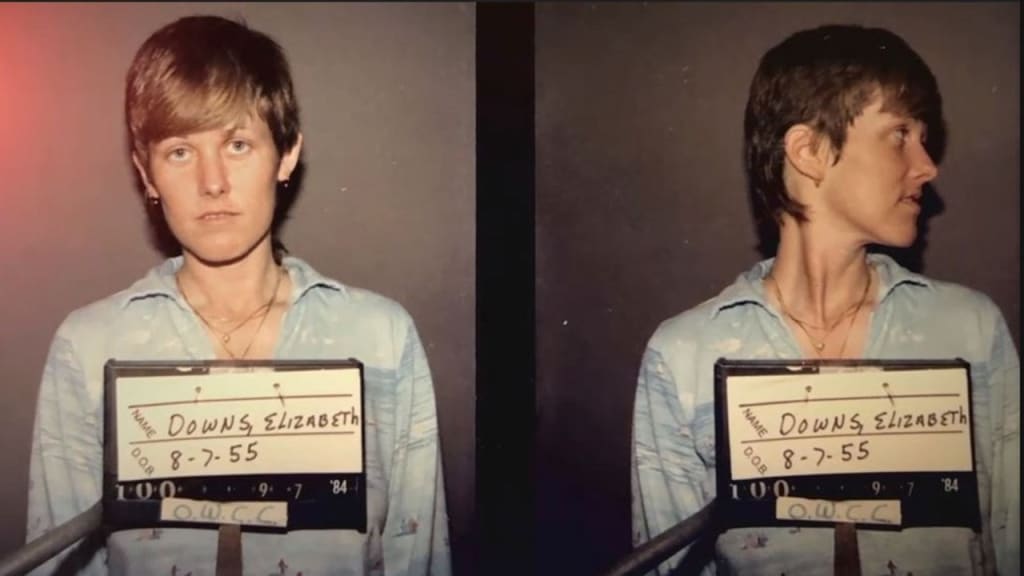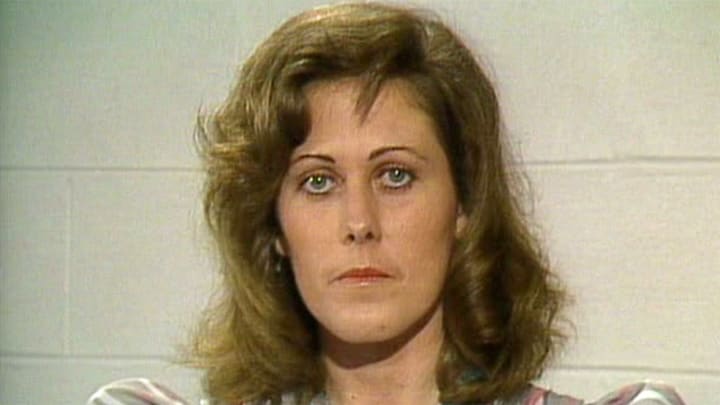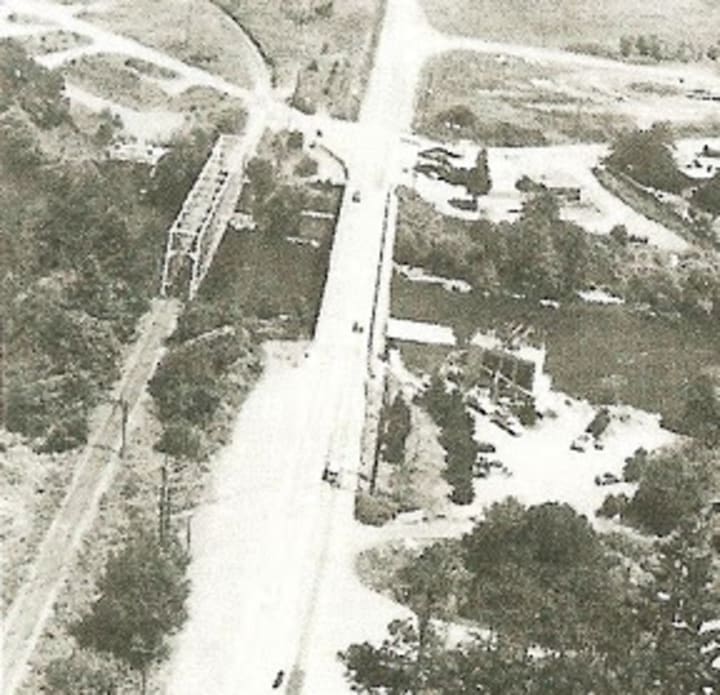Hungry Like The Wolf
Elizabeth Diane Downs

Filicide, by definition, is the deliberate act of a parent that murders their own child. The word by itself sounds as sinister as the deed, and the deed is unimaginable to most of the population. Though filicide applies to both parents, it is particularly shocking when a woman ends or attempts to end the lives of her children. Children born of her own body. How can a woman willingly and knowingly cause a defect in the flesh of her flesh, and watch as the blood of her blood spills from that defect?

Elizabeth Diane Ferguson was born August 7, 1955 in Phoenix, Arizona. She grew up in the home of Wes and Willadene Ferguson. Both worked for the United States Postal service, and Wes ruled his home with an iron fist. Rules were rules and they had to be followed or consequences would result. Elizabeth would later say that when she was eleven or twelve, Wes began a regular practice of taking his daughter on trips to the desert. It was during those trips that Elizabeth said Wes would make her remove her shirt and bra, and that he would fondle her. Wes denied that ever took place, even once. Elizabeth stated that during one of those trips to the desert they were stopped by a Highway Patrolman. During the stop, the officer took Wes aside, had a talk with him, and it was then that the abuse ended. At thirteen Elizabeth slit her wrists in a cry for attention.
It was around Elizabeth's fourteenth year that she began to change. She dyed her hair blonde, began to wear trendy and revealing clothing and insisted everyone call her by her middle name, Diane. Her very traditional parents were not happy with the changes in their daughter, but they were thrilled that Diane remained an excellent student, though she was quickly beginning to garner the attention of the boys in the neighborhood.
Diane was fifteen when she fell for the all-American boy that lived in the house across the street from the one that she shared with her parents and siblings. Steve Downs was sixteen years old, good looking and head-over-heels in love with Diane. Wes and Willadene didn't care for the boy, but Diane was in love, and she and Steve were engaging in regular sex by the time Diane was sixteen.
Upon graduation from Moon Valley High School in Phoenix, Arizona, Steve enlisted in the Navy and Diane entered Pacific Coast Baptist Bible College. Though both professed their undying love for the other, and promises to be faithful were made, it wasn't as easy as they thought it would be. Apparently for Diane, waiting patiently for Steve to return was too much and she was expelled from Pacific Coast Baptist Bible College for promiscuity.
In 1973, with Diane expelled from Pacific Coast Baptist Bible College and Steve having completed his enlistment period with the United States Navy, both were back home. The distance between them and the infidelity that took place in their relationship did little to stop the two from marrying. Although their first year of marriage was filled with accusations of continued infidelity, among other things, Diane gave birth to her first child, a girl she would name Christie.
Just six months after the birth of her first daughter, Elizabeth Diane Downs enlisted in the United States Navy. Though Diane did attend boot camp, she was only able to sustain through the first three weeks before severe blisters sent her home. Diane denies blisters were the reason for her early departure, but rather that Steve was not a good parent and was neglecting Christie.
The marriage would continue despite all the problems. By this time, Diane had found what made her happy. She often recalled her pregnancy with Christie with fondness and longed to be pregnant once more. In 1975, that dream would come to fruition with the birth of Steve and Diane's second child, daughter Cheryl Lynn.
The birth of Cheryl Lynn brought about the realization that two children were enough for Steve. Although he had a vasectomy, Diane was impregnated once again. This time Diane chose to abort the baby, but felt the need to name the aborted child Carrie.
A move to Mesa, Arizona found Steve and Diane working at a mobile home manufacturing company. Diane had several affairs with the men that worked with her and Steve Downs, and in 1979 Diane gave birth to Stephen Daniel (Danny) Downs. Steve was fully aware that there wasn't a chance that Danny was biologically his child, but he accepted Danny as his own.


Steve Downs tried to stay in the marriage, but the blatant affairs his wife was engaged in left little doubt that his marriage was over. He and Diane divorced in 1980.
Diane spent a few years after the divorce moving herself and her children in and out of different men's homes. It was during this period that Diane learned about becoming a pregnancy surrogate, and though she attempted to enroll in the program, she was denied. The results of the required testing for a pregnancy surrogate showed Diane to be highly intelligent and psychotic. Diane was proud of the fact that she was found to be psychotic and often bragged to her friends, laughing while she told the story. In between men, she often tried to reconcile with Steve, but he held fast and refused to take her back. When she met Robert Knickerbocker at work, she knew she had just met the man of her dreams. There was a problem from the beginning of the relationship, one that would not easily go away, one the couple would have to deal with. The problem? Mrs. Knickerbocker. Robert was married. Though Diane begged Robert to leave his wife, he refused. Robert wasn't going to leave his wife, and he certainly didn't want to raise another man's child. When she demanded more than to be the other woman, Robert Knickerbocker ended the relationship. A devastated and heartbroken Diane moved herself and her children to Oregon.
Diane was employed with the USPS by 1981, and was assigned to mail delivery routes in Cottage Grove. Miraculously, at the end of 1981, Diane was fully accepted into the pregnancy surrogate program. She was impregnated quickly and paid the sum of ten thousand dollars upon delivery of the child. Diane was in heaven. She had found a way to be pregnant all the time and never have to raise the children. That she would be paid large sums of money for doing what she loved anyway was a massive bonus. When asked why she loved it so much and how she could so easily carry to term and then give up a child, Diane had this to say...
"People have wondered why I won't regret this, giving up the baby, and that's very easy to answer. When you kill a child, when you have an abortion, you've terminated something." (Downs herself had earlier had an abortion.) "You've murdered somebody--it's cruel, it's horrible, it's terrible. But when you do something out of love, when you carry a child for somebody else, and turn that life over to them, you haven't done anything bad, and it's nothing you look back on and regret. It's good."
From 1981 when Diane moved to Oregon to 1983, Diane would often leave her children in care of family members while she worked. When the children were at home with Diane the neighbors worried for the children's safety. Neighbors and family members claim that Diane was growing increasingly hostile with her children. The three were often found dressed in improper clothing, and sometimes no clothing at all. Neighbors recall that Diane was especially nasty to Cheryl. Diane had a problem. She had three children. Three children that Robert had made clear that he didn't want.
May 19, 1983, Diane decided that she and her children needed to get out of the house for a while. They first went to visit with friends. At around ten that night, Diane loaded up her children for the drive home. It was a drive that would change the lives of every person in that car that evening, and shake a community to its foundation.


Diane drove south on Marcola Rd., from Marcola, Oregon, where she and her children had been visiting friends. Hungry Like The Wolf, a popular song from Duran Duran, blasted on the speakers in the car while she drove. She decided to turn off onto Old Mohawk Rd. to do a "little sightseeing" while her children slept in the car. The road is rural and there are no lights along the way. As she drove, Diane said a man stepped out into the roadway from the shoulder, waving his hands and seemingly needing help. Downs said that she stopped her car and got out, asking the man what she could do to help. She said the "shaggy haired" man told her that he wanted her car. When she refused, he shot each of her children and then shot her. She stated that she faked throwing the keys in the bushes and when the man turned to find them, she started the car and drove as fast as she could to McKenzie-Willamette Hospital in Springfield, Oregon. Diane burst through the door screaming that someone had just shot her children. Responding staff found three children inside the car, all three shot.
Eight year old Christie and three year old Danny were clinging to life as the blood ran from the holes in their tiny bodies. Seven year old Cheryl had already succumbed to her wounds by the time Diane arrived at the emergency room doors. As her three children were ushered into their respective trauma rooms, Diane was taken to her own for a gunshot wound to her left arm. Cheryl had been shot twice, once in the chest and again through her hand and chest as she attempted to ward off the bullets that were meant to end her young life. Christie had been shot in the chest and the enormous amount of blood loss she suffered caused a stroke that would leave the girl permanently paralyzed on the left side of her body. Danny was shot in the back, with the bullet striking his spine at about chest level rendering him wheel chair bound, but alive.
Doug Welch was a brand new detective when he got the call to respond to McKenzie-Willamette Hospital for the murder of young Cheryl and the attempted murders of Christie and Danny. It would be his first homicide case, and one that he would work tirelessly at, picking apart every detail in Diane's story until he could either confirm or deny by physical evidence if she was telling the truth. It didn't take Doug long to suspect that Diane wasn't telling the truth. His suspicions, in his own mind, were confirmed when Diane, all patched up, went to visit Christie for the first time since the shooting. As Diane walked in the door to the room Christie was confined to while she healed, the heart monitor connected to Christie began to beep faster, and faster. He young eyes were glazed over and she was trembling in fear. Diane was removed from the room immediately.
Diane's story was falling apart fast. Doug Welch believed in his heart that Diane Downs was responsible for the death of Cheryl and the near death of Christie and Danny. Things just didn't sit right in Doug's mind. Blood spatter inside the car was all wrong for the story she told. True enough, Diane had been shot, but Doug wondered if Diane had shot herself in an attempt to make her story believable. His suspicions were heightened considerably when he found that Diane presented at the emergency room doors with her left arm wrapped neatly in a towel. Not a single drop of blood appeared on her right arm, and there was no splatter in the driver's compartment of the car. Doug surmised that Diane had simply shot herself in a place that would injure, but not kill her, wrapped her arm in a towel and then drove herself and her children to the hospital.
Doug Welch and prosecuting attorney Fred Hugi found a witness that was driving behind Diane the night she says she was speeding to the emergency room after her children were shot. The witness said that contrary to what Diane said, she was only driving an estimated five to seven miles per hour. Further investigation led the team to search the apartment Diane lived in with her children, wherein her diary was found. The diary was full of love for Robert Knickerbocker, bordering on obsession. Robert admitted to the affair, and confirmed for investigators that he told Diane that he wouldn't leave his wife and he didn't want to raise her children, or any children for that matter.
Nine months after the shooting, Elizabeth Diane Downs was arrested on one count of murder and two counts of attempted murder. While she was waiting for trial, Diane found herself pregnant again. Just one month after her trial ended with a verdict of guilty on all three counts, and ten days before her sentencing, Diane gave birth to a baby girl that she named Amy Elizabeth. The State of Oregon took custody of baby immediately and drove her to the home of the people that would raise and love her as their own.
Lane County Judge, Gregory Foote, presided over the trial and subsequently sentenced Diane to life plus fifty years in prison, to be served consecutively, for her actions against her children. Judge Foote made abundantly clear to Diane that he wanted her to remain in prison and out of society for the remainder of her natural life, though she would be eligible to request parole upon serving twenty-five years of her sentence. She was remanded to the custody of the Oregon Women's Correctional Center in Salem, Oregon immediately to begin serving her sentence.
Diane refused to participate in any programs offered to inmates and remained adamant that it was a shaggy haired stranger that murdered her children, and that she was an innocent woman. Diane longed for freedom and it didn't take her long to obtain it. On July 11, 1987, Diane dressed in several layers of clothing and scaled the barbed wire-topped fence that surrounded the recreation yard at the Oregon Women's Correctional Center, hid under a nearby truck until she believed it to be safe, then she simply walked away. An employee of OWCC was pulling into the parking lot just as Diane was crawling out from her hiding place underneath the truck. The employee immediately alerted prison officials, telling them that a woman who bore a striking resemblance to Diane Down had just crawled from beneath a truck and walked away. The prison went into lock down immediately while a head count was completed. They were one person short on their count. Diane had done it. She had escaped the prison walls.
Diane spent the next ten days at the home of her cellmate's husband. That's where she was found, surrounded with four men, just three blocks from the prison she fled from. She was arrested and charged with escape, adding a five years to her already heft sentence. Diane was transferred to the New Jersey Department of Corrections, Edna Mahan Correctional Facility for Women in Clinton, New Jersey.
Prosecutor Fred Hugi lobbied hard for Diane to be transferred across the country, and away from his Oregon home, located just sixty-six miles from OWCC. In an unprecedented move, Fred and wife, Joanne, petitioned the State of Oregon for the right to adopt the surviving children of Diane Downs. The Hugis were granted the adoption and became the official parents of Christie and Danny. It was Hugi's fear that Diane would escape again and come to find the children that she attempted to murder that May night in 1983, perhaps finish what she started.
Diane served ten years of her sentence at the Edna Mahan Correctional Facility For Women and was then transferred to the California Department of Corrections and Rehabilitation at the Valley State Prison For Women after two more attempts to escape her life behind bars in New Jersey.

Diane is housed in the same California prison as of this writing, but she does have a hearing to determine her eligibility for parole before the Oregon Board of Parole and Post-Prison Supervision in March of 2021. Diane first applied for parole in 2008 and was immediately denied. Diane penned a handwritten, twelve-page letter to the people tasked with deciding her freedom. She explained that those that attempt to break free from prison are the ones with the healthiest attitudes towards society. An excerpt from her letter reads...
"Of all the felonies on the law books, 'escape from prison' is the only one that indicates a healthy attitude about society. If you truly want to know what sort of prisoner won't come back to prison, your first clue is the prisoner who thinks more about being on the outside of this place than being 'well programmed' or 'adjusted' HERE."
The deliberation took less than thirty minutes, was denied and the denial was explained by the parole board in no uncertain terms...
“Downs continues to fail to demonstrate any honest insight into her criminal behavior. She continues to blame others for the commission of her crimes, and blames her attorney, the police officers, the prosecutor and others for her convictions. Even after her convictions, she continues to fabricate new versions of events under which the crimes occurred.”
Will Elizabeth Diane Downs ever see the outside of prison as a free woman? Did she murder her children in cold blood, or is there a shaggy haired killer still on the loose? Is there any truth to the story that Steve, and not she owned the gun that fired the bullets that were responsible for the death of Cheryl and the grievous injuries of Christie and Danny?
Christie and Danny grew up in the household of Fred and Joann Hugi. They are both successful adults with families of their own. Amy Elizabeth was adopted and given an new name, Rebecca. Rebecca is a behavioral specialist in Oregon where she, Danny and Christie still reside.
About the Creator
Phoenixx Fyre Dean
Phoenixx lives on the Oregon coast with her husband and children.
Author of Lexi and Blaze: Impetus, The Bloody Truth and Daddy's Brat. All three are available on Amazon in paperback format and Kindle in e-book format.






Comments
There are no comments for this story
Be the first to respond and start the conversation.